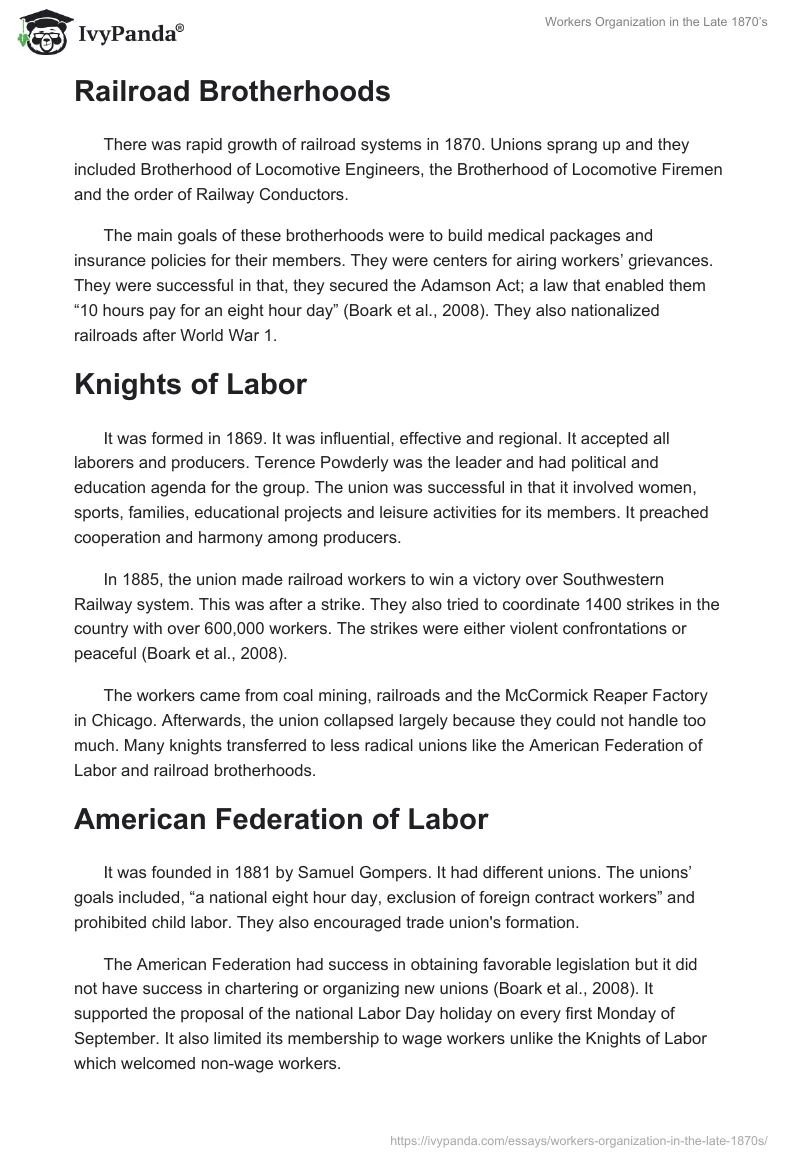Workers organization in the late 1870’s can also be referred to as labor history. This describes the history of labor that happened in the United States. Labor federations and unions evolved, split and merged in the 1870’s due to various factors. Solidarity was the main theme, individual rights and democracy.
Early Unions
Most trade unions were formed after the Civil War. The National Labor Union was the first to be formed. There were also strikes by women who worked in bad conditions in shops. They earned 1.25$ or 2$ per week. The weavers bought their thread and needles from their proprietor. There were also fines for being “few minutes late” when reporting to work.
They also carried their treadle machines and if they protested, this resulted in dismissal. Often whole families would work from daytime till midnight and this resulted in some illness due to dust accumulation on the tables and floors. Others worked in cold weather caused by leaking of shops from openings on the roofs. This caused women to strike and the Daughters of Liberty was formed. In 1871, they later named themselves the United Tailoresses of New York (Boark et al., 2008). They formed strikes and they succeeded in some.
Order of the Knights of St. Crispin
It was formed in 1867 and had 50 000 members in 1870. There was Daughters of St. Crispin which was founded in 1870. The aim of this union was to fight against the encroachment of machinery in the shoe making industry but they failed because the machines that were introduced were easy to operate.
They produced more and better quality shoes than hand sewed shoes. The machines were also operated by unskilled and semi- skilled workers.
Railroad Brotherhoods
There was rapid growth of railroad systems in 1870. Unions sprang up and they included Brotherhood of Locomotive Engineers, the Brotherhood of Locomotive Firemen and the order of Railway Conductors.
The main goals of these brotherhoods were to build medical packages and insurance policies for their members. They were centers for airing workers’ grievances. They were successful in that, they secured the Adamson Act; a law that enabled them “10 hours pay for an eight hour day” (Boark et al., 2008). They also nationalized railroads after World War 1.
Knights of Labor
It was formed in 1869. It was influential, effective and regional. It accepted all laborers and producers. Terence Powderly was the leader and had political and education agenda for the group. The union was successful in that it involved women, sports, families, educational projects and leisure activities for its members. It preached cooperation and harmony among producers.
In 1885, the union made railroad workers to win a victory over Southwestern Railway system. This was after a strike. They also tried to coordinate 1400 strikes in the country with over 600,000 workers. The strikes were either violent confrontations or peaceful (Boark et al., 2008).
The workers came from coal mining, railroads and the McCormick Reaper Factory in Chicago. Afterwards, the union collapsed largely because they could not handle too much. Many knights transferred to less radical unions like the American Federation of Labor and railroad brotherhoods.
American Federation of Labor
It was founded in 1881 by Samuel Gompers. It had different unions. The unions’ goals included, “a national eight hour day, exclusion of foreign contract workers” and prohibited child labor. They also encouraged trade union’s formation.
The American Federation had success in obtaining favorable legislation but it did not have success in chartering or organizing new unions (Boark et al., 2008). It supported the proposal of the national Labor Day holiday on every first Monday of September. It also limited its membership to wage workers unlike the Knights of Labor which welcomed non-wage workers.
The Knights disappeared but AFL continued to grow even in the 19th Century. The members were primarily both skilled and unskilled workers, and African-Americans. Women were excluded since they saw that they worked for smaller wages.
Conclusion
There were other strikes that continued in the late1890’s and 1900 like Pullman strike. It occurred due to a reduction of wages by the Pullman Palace Car Company following an economic depression in 1890. The workers joined the American Railway Union which was led by Eugene V. Debs (Boark et al., 2008).
This union supported the Pullman strike by refusing to switch cars that belonged to Pullman onto trains. 125, 000 workers on 29 railroads quitted their jobs instead of handling Pullman cars. The strike was interfered by United States Marshal and 2,000 United States Army troops. Some strikers were killed, others wounded and property damaged. This led to disintegration of the American Railway Union.
Some workers organizations of the 1870’s were successful and others were not. This depended on their goals. For instance, Order of the Knights of St. Crispin was unsuccessful because their aims were to fight against the introductions of machines in factories. They saw that the machines would replace them. The machines were easy to operate and produced more shoes hence their strikes failed. Other unions succeeded like Railroad Brotherhoods due to better management, solidarity and worked in harmony.
References
Boark, J. L. et al. (2008). The American Promise: A Compact History. 4th Ed. Bedford: St. Martin’s.


